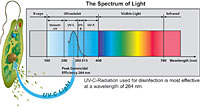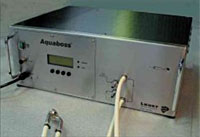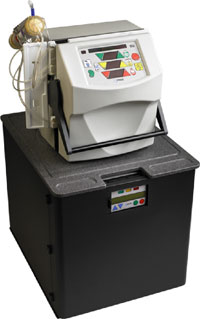Water Treatment for Home Hemodialysis
When you do hemodialysis (HD), your blood is exposed to 25 to 50 times or more water than you could drink in a week. Drinking water can have small amounts of bacteria, metals, and chemicals that don't harm most people—but could build up in your body and make you sick. Water treatment helps keep you safe.
Hemodialysis and Water

In HD, blood flows through the inside of hollow fibers in the dialyzer (see Figure 1). Dialysate—water and a precise mix of chemicals—bathes the outside of the fibers.
The fibers are a semipermeable membrane—they have microscopic holes. The holes let small wastes pass out of your blood and into the dialysate. But some bacteria, chemicals, or metals—which are small, too—could pass from the dialysate water into your blood.
Water May Look Clear, But...
Farms. Factories. Floods. Water gains toxins and contaminants in a number of ways. Farm runoff has pesticides and animal waste. Rain picks up dust, gases, and smoke from factories as it falls to the ground, turning it acidic. Acid rain can then dissolve minerals out of rocks, adding metals to ground water (wells and springs) and surface water (lakes, ponds, rivers). Cities add chemicals to treat water, which can harm people on HD.1
Substances that must be removed from dialysis water include:
- Bacteria
- one-celled microbes that can cause disease. Bacteria form biofilm (slime) that lets them cling to wet surfaces.
- Endotoxin
- these toxic parts of bacteria cell walls are freed when the bacteria die. Endotoxin can cause fever and chills in people on HD.
- Nitrates
- part of some fertilizers, these can keep your body from using oxygen.
- Calcium & magnesium
- these minerals can cause "hard water syndrome"—nausea, vomiting, headaches, skin flushing, weak muscles, and blood pressure changes.
- Sodium & potassium
- since these electrolytes are part of dialysate, they must be kept in precise amounts. Extra levels in water must be removed.
- Sulfates
- this class of minerals can cause nausea and vomiting in people on HD.
- Copper & zinc
- soft water can cause these toxic metals to leach out of plumbing pipes or water cisterns. In the body, they can cause nausea and vomiting, liver damage, death of red blood cells, and other problems.
- Heavy metals
- arsenic, barium, cadmium, chromium, lead, mercury, and selenium can be poisons and can build up in the body.
- Chloramines
- mixing chlorine and ammonia makes a toxic gas used to kill bacteria in drinking water. It must be removed from dialysis water.
- Aluminum
- can occur in nature or be added (as alum) to make city water more clear. It can build up in the bones and brains of people on HD.
- Fluoride
- added to city water to help prevent tooth decay, but harmful to people on HD.
U.S. Water Safety Standards
The U.S. Environmental Protection Agency (EPA) wrote standards for drinking water in 1974, with the Clean Water Act. Safe levels were set for a wide array of contaminants, from certain bacteria to asbestos, metals, pesticides, and even cyanide.2
In the U.S., dialysis water standards are set by the Association for the Advancement of Medical Instrumentation (AAMI).3
Treating Water for Home HD
The first step in treating water for home HD is ensuring that your feed water (coming into your home) meets EPA drinking water standards. Your center may ask you to bring in a sample of your water for testing. If it fails the tests, you may need to use bagged dialysate (i.e., NxStage®) instead of treating your water.
Once your water is known to meet the EPA standards, you'll need a way to remove bacteria, chemicals, and metals.
Removing bacteria
Some bacteria are very happy to grow in water. To keep them from affecting your water treatment system, you may need to disinfect it. Each system has a different way to control bacteria. With the NxStage PureFlow system, you just get a new one every three months or so.

Ultraviolet (UV) light (see Figure 2) is used in some water treatment systems to kill bacteria. UV light breaks down their DNA so they die or can't reproduce.
When bacteria die, endotoxin is released. One or more ultrafilters —filters that remove very small particles—are used to remove bacteria and endotoxin from HD water. These filters are replaced on a schedule to be sure they don't have a chance to wear out.
"Ultrapure" water has gone through an ultrafilter. By AAMI Guidelines, dialysate must have less than 0.1 colony forming units (CFUs) of bacteria in a milliliter to be ultrapure. Research has found that ultrapure dialysate is less likely to cause inflammation than standard dialysate, which can have up to 200 CFUs.4,5,6 To learn more, read our September 2005 article on ultrapure dialysate.
Removing Chemicals and Metals
Reverse osmosis (RO) uses a membrane and pressure to remove dissolved chemicals and metals (solutes) from water. A pump is used to force water through the membrane. Pure water passes through, while chemicals and metals are sent to the drain. RO is also used to take salt out of seawater.
RO membranes are fragile. They work best at a water temperature of 77°F, so your system may have a heater. A filter or two may be placed in the water path before the RO to catch particles that could tear the membrane. The pump may be noisy. RO systems also use a lot of water.
Removing chlorine
The EPA requires all towns to add chlorine to their water systems to keep bacteria levels down. Chlorine must be removed from dialysate water, or it will harm red blood cells. It is not removed well by the RO, and can damage RO membranes. Activated carbon is used to remove chlorine.
Putting it all together
In a dialysis center, the water treatment system may take up a whole room. For home use, water treatment has been streamlined. It is smaller and quieter than in-center equipment, and easier to use.

The Fresenius Aquaboss® system works with the 2008K at Home machine. 7 The Aquaboss is small and quiet. Water flows through it in a loop to keep bacteria from growing. Menus on the screen make the system easy to use.
Two carbon tanks are used with the Aquaboss. These tanks remove organic chemicals, like chlorine, from the water. They don't have to be in the same room as the 2008K machine or the Aquaboss. Some plumbing and wiring changes may be needed for these machines.
Three other companies make stand alone RO machines for use with home HD. Read more about these systems.

NxStage has an all-in-one water treatment that works with its System One HD cycler. The NxStage® PureFlow SL™ is a compact dialysate preparation system about the size of a standard end table. Its integrated water purification pack makes ultrapure water from tap water. The ultrapure water then mixes with sterile dialysate concentrate to make 60L of high-purity dialysate. The PureFlow SL needs no special plumbing or electrical changes to the home, just a simple faucet or under-sink connection and standard electrical outlet.
Testing Your HD Water
Your town's water treatment can vary from day to day. If there are heavy rains, there may be more bacteria. If they are flushing the lines, more metal may come through. If the water is murky, they may use more alum. Your dialysis home training staff will talk with your water treatment plant and tell them that you are doing home HD. They will alert you if your town does something to affect water quality.
With any home HD water treatment system, you'll need to do some testing to be sure your water is safe to use. Before every treatment (or with every batch with the PureFlow SL™) you will test the water with a simple test strip to make sure you do not have any chlorine or chloramines in the water. You will also need to take a sample of your water and send it to your lab on a schedule. They will test for bacteria and chemicals to make sure the water is safe for dialysis.
Be Alert for Symptoms
Report any new symptom you have to your home HD nurse or nephrologist. Even common symptoms like nausea or vomiting can sometimes be caused by a water treatment failure. Fevers, blue lips and fingernails, headaches, skin flushing, even blood pressure changes may be related to water—or not. Health issues at home that go away if you come into the center for a treatment or two are a reason to check your water system.
Your blood aluminum levels should be tested at least once a year—or every three months if you take drugs that contain aluminum. 8
Keeping your water treatment system in good working order will help you protect your health.
References:
- Jim Curtis, Philip Varughese. Water Treatment. Module 8 in The Core Curriculum for the Dialysis Technician. Amgen, 2006. www.meiresearch.org
- Drinking Water Contaminants (accessed 8/22/07).
- AAMI Publications: Dialysis
- Arizono K, Nomura K, Motoyama T, Matsushita Y, Matsuoka K, Miyazu R, Takeshita H, Fukui H. Use of ultrapure dialysate in reduction of chronic inflammation during hemodialysis. Blood Purif. 2004; 22 Suppl 2:26-9.
- C.M. Kjellstrand,C.R. Blagg , Z. Twardowski , J. Bower. Appproaches to Qutidian Dialysis: The Aksys Personal Hemodialysis System. Sem Dial. 17: 151-153. 2004
- Hsu PY, Lin CL, Yu CC, Chien CC, Hsiau TG, Sun TH, Huang LM, Yang CW. Ultrapure dialysate improves iron utilization and erythropoietin response in chronic hemodialysis patients—a prospective cross-over study. J Nephrol. 2004 Sep-Oct; 17(5):693-700.
- Aquaboss Specifications
- K/DOQI Clinical Practice Guidelines for Bone Metabolism and Disease in Chronic Kidney Disease

